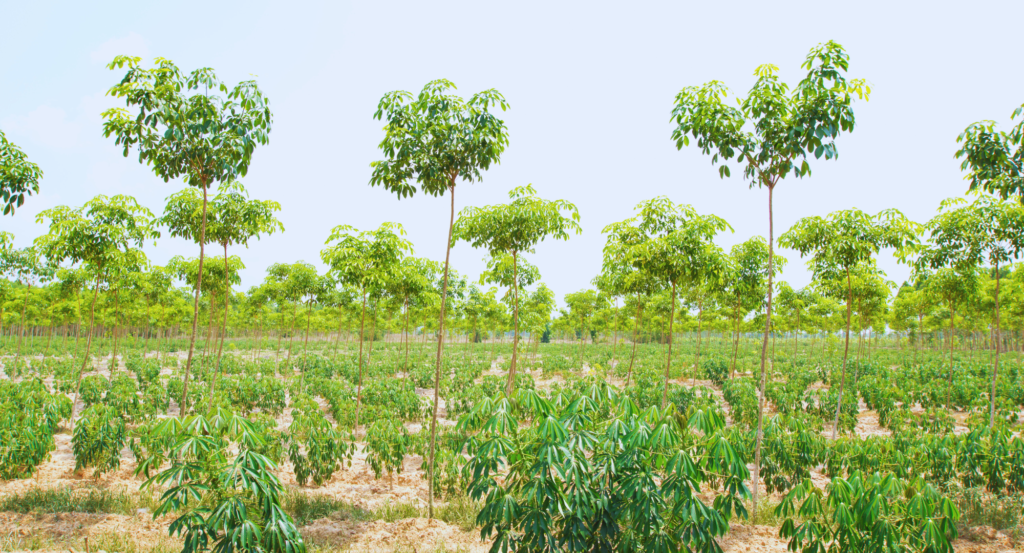The Importance of Agroforestry has become increasingly evident in today’s pursuit of sustainable agriculture. This time-honored practice integrates trees and shrubs into farming landscapes, offering a comprehensive approach to land management that harmonizes productivity with environmental care. Agroforestry’s benefits go far beyond crop yields; it significantly boosts biodiversity, aids in climate change mitigation, and enhances community livelihoods. Ecowood Habitat exemplifies these advantages, leading the way with innovative agroforestry techniques and demonstrating the transformative potential of this approach.

The Basics of Agroforestry:
Agroforestry involves the deliberate placement of trees, shrubs, and other vegetation alongside crops or pasturelands. This practice is designed to optimize the use of land, improve soil health, and create more resilient agricultural systems. By mimicking natural ecosystems, agroforestry promotes biodiversity and helps in restoring degraded lands. Key components of agroforestry include:
- Silvopasture: The integration of trees with livestock grazing, which provides shade and improves pasture productivity.
- Alley Cropping: Planting rows of trees or shrubs between crops reduces erosion and enhances soil fertility.
- Forest Farming: Cultivating high-value crops like mushrooms, herbs, or fruits under the canopy of trees, adding economic value to the land.
- Windbreaks: Establish tree lines to protect crops from wind damage and reduce soil erosion.
Each of these methods contributes to a more diverse and resilient farming system, with the potential to transform agricultural landscapes into thriving, sustainable ecosystems.
Environmental Benefits of Agroforestry:
Agroforestry is a powerful tool for environmental conservation. The presence of trees in agricultural landscapes offers numerous ecological benefits:
Climate Change Mitigation: Trees act as carbon sinks, sequestering carbon dioxide from the atmosphere and helping to mitigate the effects of climate change. The deep roots of trees also stabilize soil, reducing the risk of erosion and flooding.
Biodiversity Enhancement: By creating a more diverse habitat, agroforestry supports a wider range of species, including beneficial insects, birds, and soil microorganisms. This biodiversity contributes to healthier crops and reduced reliance on chemical inputs.
Soil Health Improvement: Trees and shrubs improve soil structure, enhance nutrient cycling, and increase organic matter. This leads to healthier soils that are more productive and better able to retain moisture.
Water Conservation: The root systems of trees help in retaining water in the soil, reducing the need for irrigation and improving the resilience of crops during drought conditions.
Economic and Social Benefits:
Beyond environmental advantages, agroforestry also offers significant economic and social benefits:
Diversified Income Streams: Agroforestry allows farmers to harvest multiple products, such as timber, fruits, nuts, and medicinal plants, in addition to traditional crops. This diversification reduces economic risk and increases financial stability.
Enhanced Livelihoods: By improving soil fertility and crop yields, agroforestry enhances food security and provides opportunities for income generation, especially in rural communities.
Community Resilience: Agroforestry practices can be tailored to local conditions, making them accessible to small-scale farmers. By promoting sustainable land management, agroforestry helps communities adapt to changing environmental conditions and build resilience against climate-related challenges.
Agroforestry at Ecowood Habitat:
Ecowood Habitat is a shining example of how agroforestry can be successfully integrated into modern agricultural practices. Nestled near the Gollapalli Reservoir, Ecowood Habitat has embraced agroforestry as a core principle in its managed farmlands. By planting a diverse range of trees alongside crops, Ecowood Habitat has created a vibrant ecosystem that benefits both the environment and the community.
Key Agroforestry Practices at Ecowood Habitat:
- Silvopasture Integration: Ecowood Habitat has introduced silvopasture systems where livestock graze under the shade of trees. This not only improves animal welfare but also enhances soil fertility and reduces the need for chemical fertilizers.
Alley Cropping for Soil Health: The use of alley cropping at Ecowood Habitat has significantly improved soil health. The trees planted between crop rows reduce soil erosion, enhance nutrient cycling, and provide additional income through the sale of timber and fruits.
Community Engagement: Ecowood Habitat actively involves the local community in agroforestry practices, offering training and resources to help farmers adopt sustainable land management techniques. This community-focused approach ensures the long-term success of agroforestry initiatives and fosters a sense of shared responsibility for the environment.
The Future of Agroforestry:
As the global population grows and the demand for food increases, the importance of sustainable agricultural practices like agroforestry cannot be overstated. Agroforestry offers a viable solution to many of the challenges facing modern agriculture, from climate change to soil degradation. By promoting biodiversity, improving soil health, and providing economic opportunities, agroforestry can play a central role in creating a more sustainable and resilient food system.
At Ecowood Habitat, the commitment to agroforestry is more than just a practice—it’s a philosophy. By integrating trees into agricultural landscapes, Ecowood Habitat is paving the way for a greener, more sustainable future. The success of agroforestry at Ecowood Habitat serves as an inspiration for other farms and communities, demonstrating that sustainable agriculture is not only possible but also highly beneficial.
Conclusion:
The importance of agroforestry lies in its ability to harmonize the needs of agriculture with the demands of environmental conservation. By incorporating trees into farming systems, agroforestry creates a more resilient, productive, and sustainable agricultural landscape. Ecowood Habitat exemplifies the potential of agroforestry, showcasing how this ancient practice can be adapted to meet the challenges of the modern world. As we look to the future, embracing agroforestry will be essential in building a sustainable food system that supports both people and the planet.



